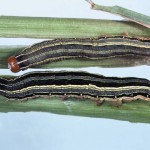
- Common armyworm Leucania convecta
- Northern armyworm Mythimna separata
- Lawn armyworm Spodoptera mauritia
Fall armyworm (FAW; Spodoptera frugiperda) arrived in Australia in early 2020. While it has so far shown a marked preference for maize, sweet corn and sorghum crops, it has the potential to damage winter cereals in some seasons.
| Pre-emergence to flowering | Grain development and Ripening | |
|---|---|---|
| Insects and damage | Armyworm prefer lush growth that provides good cover and protection. They feed on leaf tissue – leaf margins have tattered/chewed/scalloped appearance; in extreme cases whole leaves may be severed at the stem.
Caterpillars produce green/straw coloured droppings (size of match head). These are visible between the rows. Bare patches adjacent to barley fields or damage to weeds may indicate armyworm presence before it is evident in crops. |
In oats, pieces of panicles can be bitten off causing grain to fall to the ground.
Armyworm are most damaging in barley close to harvest. The larvae chew through stems below the head causing heads to drop. |
| Monitoring |
|
|
| Beneficials | Around 20 species of predators and parasitoids have been recorded attacking armyworm. Frequently observed predators include predatory shield bugs, ladybeetles, carabid beetles, lacewings and common brown earwigs. Parasitoids include tachnid flies and a number of wasp species (e.g. Netelia, Lissopimpla, Campoletis). Viral and fungal diseases can cause armyworm mortality; such outbreaks are more common at high armyworm densities. | |
| Cultural control |
Larvae can move into cereals if adjacent pastures are chemically fallowed, spray topped or cultivated in spring. Monitor for at least a week post treatment. Damage is generally confined to crop margins. |
Windrow or dessicate barley as an alternative to spraying for armyworm if rapid drying conditions are forecast. |
| Thresholds |
|
|
| Pesticides |
|
|
| Multi-pest considerations | Control of armyworm in early crop development can have off-target impact on other cereal pests e.g. helicoverpa, aphids and mites. Exposure to synthetic pyrethroids in these pests will contribute to selection pressure for SP resistance. This is a consideration for insecticide use and selection, particularly in the northern region where H. armigera is prevalent and pests may move from winter crops to subsequent summer crops. In the southern and western regions, SP use in winter cereals for armyworm may hasten or exacerbate SP resistance in earth mite species. | |
| Communication | Good communication and sharing information with neighbours through area wide management may provide first indication of army worm presence
Industry publications provide up to date information about regional pest issues |
|
Further information
- Armyworm (PestWeb Agriculture WA)
- The Beatsheet blog (select armyworm)
- Armyworms in field crops (DAF Queensland)
- Armyworm (cesar PestNotes)
- Armyworms (Agriculture Victoria)
